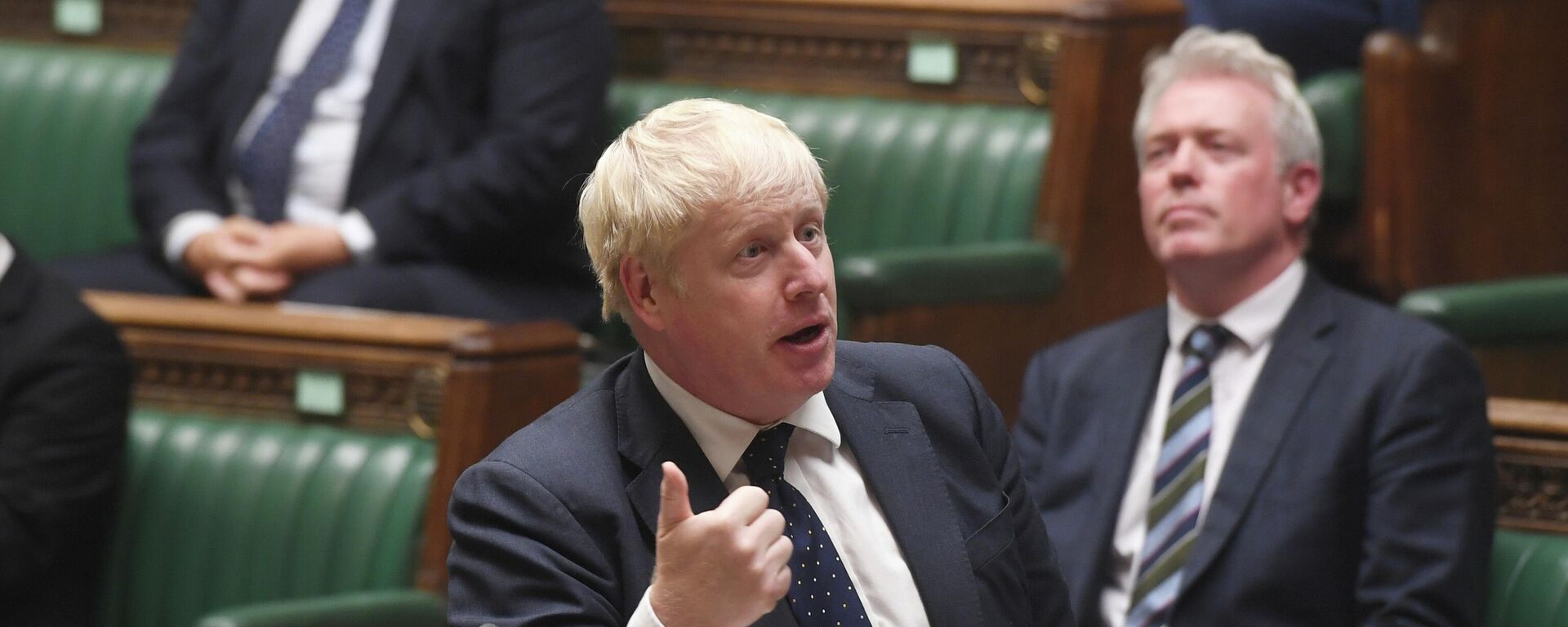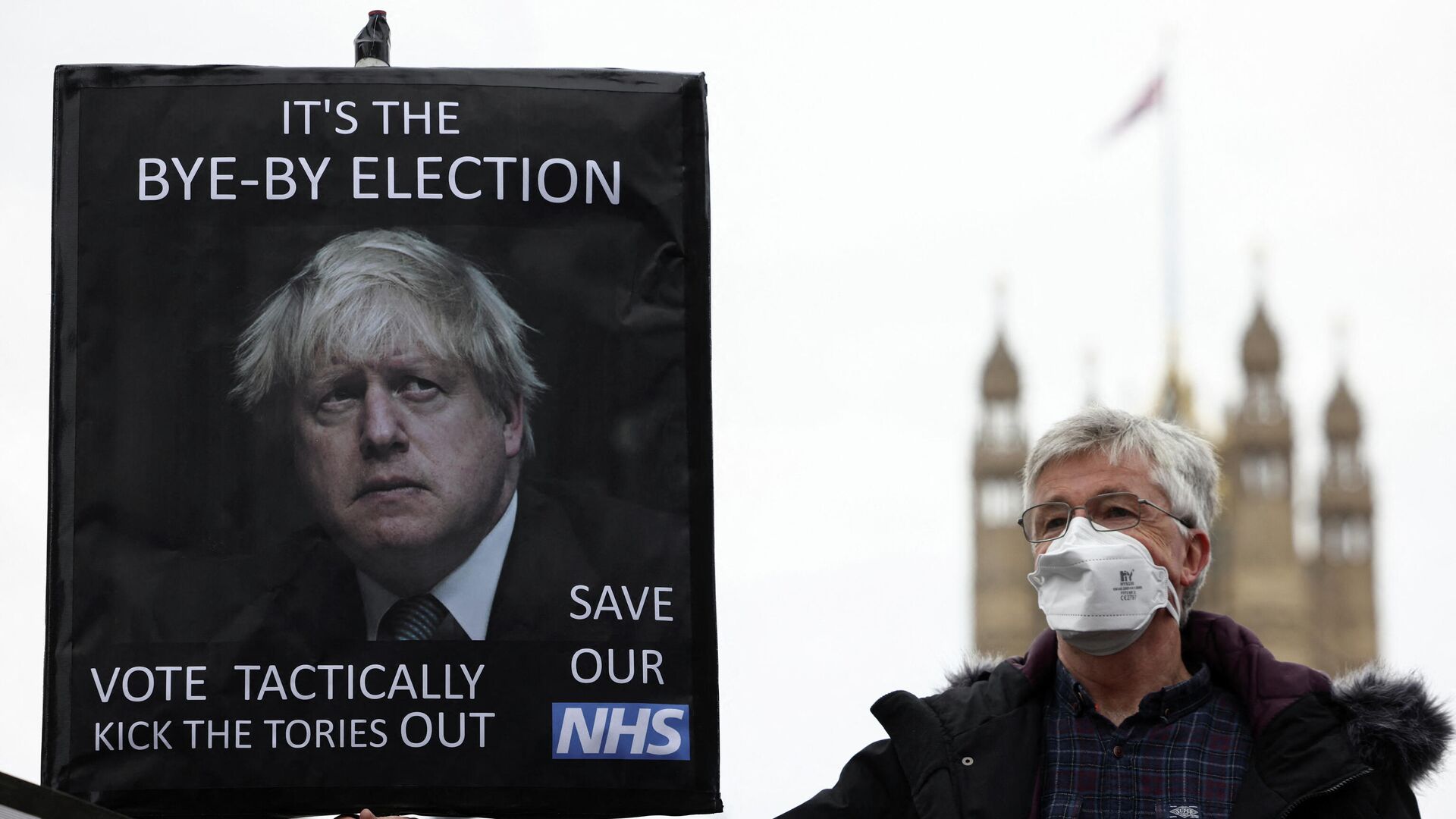https://sputnikglobe.com/20211216/as-embattled-boris-johnson-may-face-no-confidence-vote-how-is-it-triggered-and-what-does-it-entail-1091569668.html
As Embattled Boris Johnson May Face No Confidence Vote, How is it Triggered and What Does it Entail?
As Embattled Boris Johnson May Face No Confidence Vote, How is it Triggered and What Does it Entail?
Sputnik International
After Boris Johnson faced the biggest Tory revolt of his premiership on 14 December, speculations have been fueled as to a possible leadership challenge.
2021-12-16T10:50+0000
2021-12-16T10:50+0000
2023-05-28T15:17+0000
boris johnson
uk conservative party
united kingdom (uk)
https://cdn1.img.sputnikglobe.com/img/07e5/0c/10/1091570405_0:73:3071:1800_1920x0_80_0_0_fce849a27489b4a6da41a43b226511c3.jpg
After Boris Johnson faced the biggest Tory revolt of his premiership on 14 December, when a total of 99 Conservatives voted against the so-called Plan B on tougher COVID-19 rules for England this winter, speculations have been fuelled as to a possible leadership challenge.The Plan B measure, which includes introduction of health certificates for nightclubs and large events in England, was passed by a majority of 243 thanks to Labour support on Tuesday, but left out-of-patience Tory backbenchers issuing a plethora of warnings. A leadership challenge has “got to be on the cards” unless the Prime Minister alters his handling of matters, veteran Tory backbencher Sir Geoffrey Clifton-Brown and treasurer of the 1922 Committee was cited as saying. Furthermore, at least two dozen letters of no confidence in Prime Minister Boris Johnson could be submitted to Chairman of the 1922 Committee Sir Graham Brady, who will reportedly be receiving them over Christmas, Conservative MPs were cited as saying by The Telegraph. The Prime Minister who helped the Conservatives win a large majority in the 2019 election has been doggedly fending off “Tory sleaze” allegations in the wake of the Owen Paterson lobbying scandal. He has also faced a backlash amid questions over who funded a pricey refurbishment of his apartment on Downing Street and claims of illicit lockdown-breaching Christmas parties held at No 10 last year during strict COVID-19 restrictions.In November, he produced a disastrous speech to the Confederation of British Industry (CBI) Annual Conference, where he waxed lyrical about a recent trip to Peppa Pig World and lost his place in his notes. At the time, a dozen backbenchers are said to have written to Sir Graham Brady, voicing their discontent with Johnson’s recent performances. As the UK PM does not have a direct mandate from the voters, with the party with the greatest number of MPs forming the government, if a sizeable number of disgruntled lawmakers opt for a new leader, this could become reality. How is No Confidence Vote Triggered? The 1922 Committee of backbench Tory MPs, formally known as the Conservative Private Members' Committee, is the parliamentary group of the UK Conservative Party in the House of Commons. It meets weekly while parliament is in session and plays a pivotal role in deciding the fate of its party leaders. “The 22” has an 18-member executive committee, the chairman of which oversees the election of party leaders, or any Conservative party-led vote of no confidence in a sitting leader. Such a vote can be triggered if 15 per cent of Conservative MPs from the party’s pool of 360 lawmakers write a letter to the chairman asking for such a vote. As the Conservatives currently have 361 MPs, 55 letters would need to be submitted to 1922 Committee chairman Sir Graham Brady. As letters are handed in confidentially, only the chairman is likely to be aware of the tally. Should Sir Graham Brady receive enough afore-said letters to proceed and a party vote did take place in the form of a secret ballot, the Prime Minister would need to secure a simple majority (more than 50 percent) to stay on. Furthermore, if Johnson were to secure a majority, he would be guaranteed a full-year’s immunity from further no-confidence challenges. Leadership Contest If the Conservative Party leader does not secure the confidence votes of half of their backbench MPs plus one, a general election would not automatically be triggered, as his replacement would become PM. The 1922 Committee would set the timetable for a leadership contest. To participate in the race, a Tory MP has to be nominated by two colleagues. A secret vote is held among Conservative MPs if several candidates come forward, with the process whittled down to two candidates. These are then put to a postal ballot of the wider Conservative Party membership. The winner is named the new leader. As for the two MPs considered by some as frontrunners to replace Boris Johnson, some sources are cited as naming Chancellor Rishi Sunak and Foreign Secretary Liz Truss. In recent UK history, Theresa May won the backing of her party to stay on as prime minister despite the fact that more than a third of Conservative MPs voted against her. Tory MPs rejected a no-confidence motion in May by 200 votes to 117 amid a bitter split in her party over Brexit. As for the last time a leader lost such a vote, it occurred on 29 October 2003, when Iain Duncan Smith was defeated 90 to 75, forcing him out of office.
https://sputnikglobe.com/20211216/old-boris-magic-wearing-thin-tory-rebels-warn-pm-of-possible-leadership-challenge-on-the-cards-1091560395.html
https://sputnikglobe.com/20210907/bojo-and-rishis-booze-shmooze-of-tory-backbenchers-at-1922-committee-social-1088846205.html
united kingdom (uk)
Sputnik International
feedback@sputniknews.com
+74956456601
MIA „Rosiya Segodnya“
2021
News
en_EN
Sputnik International
feedback@sputniknews.com
+74956456601
MIA „Rosiya Segodnya“
Sputnik International
feedback@sputniknews.com
+74956456601
MIA „Rosiya Segodnya“
boris johnson, uk conservative party, vote of no confidence, tory mps, leadership contest
boris johnson, uk conservative party, vote of no confidence, tory mps, leadership contest
As Embattled Boris Johnson May Face No Confidence Vote, How is it Triggered and What Does it Entail?
10:50 GMT 16.12.2021 (Updated: 15:17 GMT 28.05.2023) Tuesday's second-biggest ever rebellion by Tory MPs against their own sitting Prime Minister dealt Boris Johnson, who is grappling with a succession of scandals, another blow. Despite tighter coronavirus restrictions being passed, Conservative MP Geoffrey Clifton-Brown suggested that a leadership challenge has “got to be on the cards”.
After Boris Johnson faced the biggest Tory revolt of his premiership on 14 December, when a total of 99 Conservatives voted against the so-called Plan B on tougher COVID-19 rules for England this winter, speculations have been fuelled as to a possible leadership challenge.
The Plan B measure, which includes introduction of health certificates for nightclubs and large events in England, was passed by a majority of 243 thanks to Labour support on Tuesday, but left out-of-patience Tory backbenchers issuing a plethora of warnings.

16 December 2021, 05:49 GMT
A leadership challenge has “got to be on the cards” unless the Prime Minister alters his handling of matters, veteran Tory backbencher Sir Geoffrey Clifton-Brown and treasurer of the 1922 Committee was cited as saying. Furthermore, at least two dozen letters of no confidence in Prime Minister Boris Johnson could be submitted to Chairman of the 1922 Committee Sir Graham Brady, who will reportedly be receiving them over Christmas, Conservative MPs were cited as saying by The Telegraph.
The Prime Minister who helped the Conservatives win a large majority in the 2019 election has been doggedly fending off “Tory sleaze” allegations in the wake of the Owen Paterson lobbying scandal. He has also faced a backlash amid questions over who funded a pricey refurbishment of his apartment on Downing Street and claims of illicit
lockdown-breaching Christmas parties held at No 10 last year during strict COVID-19 restrictions.
In November, he produced a
disastrous speech to the Confederation of British Industry (CBI) Annual Conference, where he waxed lyrical about a recent trip to Peppa Pig World and lost his place in his notes. At the time, a dozen backbenchers are said to have
written to Sir Graham Brady, voicing their discontent with Johnson’s recent performances.
As the UK PM does not have a direct mandate from the voters, with the party with the greatest number of MPs forming the government, if a sizeable number of disgruntled lawmakers opt for a new leader, this could become reality.
How is No Confidence Vote Triggered?
The 1922 Committee of backbench Tory MPs, formally known as the Conservative Private Members' Committee, is the parliamentary group of the UK Conservative Party in the House of Commons. It meets weekly while parliament is in session and plays a pivotal role in deciding the fate of its party leaders.
“The 22” has an 18-member executive committee, the chairman of which oversees the election of party leaders, or any Conservative party-led vote of no confidence in a sitting leader. Such a vote can be triggered if 15 per cent of Conservative MPs from the party’s pool of 360 lawmakers write a letter to the chairman asking for such a vote.

7 September 2021, 15:16 GMT
As the Conservatives currently have 361 MPs, 55 letters would need to be submitted to 1922 Committee chairman Sir Graham Brady. As letters are handed in confidentially, only the chairman is likely to be aware of the tally.
Should Sir Graham Brady receive enough afore-said letters to proceed and a party vote did take place in the form of a secret ballot, the Prime Minister would need to secure a simple majority (more than 50 percent) to stay on. Furthermore, if Johnson were to secure a majority, he would be guaranteed a full-year’s immunity from further no-confidence challenges.
If the Conservative Party leader does not secure the confidence votes of half of their backbench MPs plus one, a general election would not automatically be triggered, as his replacement would become PM. The 1922 Committee would set the timetable for a leadership contest.
To participate in the race, a Tory MP has to be nominated by two colleagues. A secret vote is held among Conservative MPs if several candidates come forward, with the process whittled down to two candidates. These are then put to a postal ballot of the wider Conservative Party membership. The winner is named the new leader.
As for the two MPs considered by some as frontrunners to replace Boris Johnson, some sources are cited as naming Chancellor Rishi Sunak and Foreign Secretary Liz Truss.
In recent UK history,
Theresa May won the backing of her party to stay on as prime minister despite the fact that more than a third of Conservative MPs voted against her. Tory MPs rejected a no-confidence motion in May by 200 votes to 117 amid a bitter split in her party over Brexit. As for the last time a leader lost such a vote, it occurred on 29 October 2003, when Iain Duncan Smith was defeated 90 to 75, forcing him out of office.






